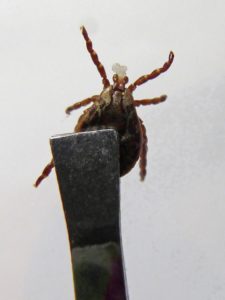 The duration of flea and tick season can vary depending on where you live.
The duration of flea and tick season can vary depending on where you live.
Some regions are affected throughout the entire year while in other areas the peak season is just beginning as temperatures rise and trees, plants, and grass spring to life.
No matter where you live, knowing how to protect your precious pet from potential distress, harm or disease is a number one priority.
Here are some questions and answers to contemplate that will help keep your pet safe year-round.
-
How can I protect my pet from fleas and ticks?
- Over-the-counter preventative products are safe and effective. They come in pill, liquid, and topical forms generally administered once a month. Collars, shampoos, and sprays are also available. Always follow package directions or consult your vet when treating your pet.
- Your vet can prescribe a medication that also includes dewormer and heartworm prevention.
- Keep pets away from densely wooded areas and tall grass; have a safe outdoor environment for your pet by keeping the grass cut short and shrubs and bushes trimmed.
- Check pets daily during flea and tick season including your indoor pets.
-
What are the signs that my pet has fleas?
 Extreme scratching and increased grooming – more biting and chewing at the fur and skin.
Extreme scratching and increased grooming – more biting and chewing at the fur and skin.- Patches of bare skin from scratching excessively.
- Brown or black specks that resemble coffee grounds on your pet when brushing or combing or in their bedding.
- Some pets have an allergic reaction at the bite site in some pets, while others show little discomfort.
-
What should I do if my dog or cat gets fleas?
- If you believe your pet is infested with fleas, make an appointment with your vet to make sure there is no infection or health issue.
- Your vet can recommend a safe and effective treatment to kill the fleas. Multiple treatments may be necessary to eliminate the infestation.
- All pets in your household should be treated even if only one pet is showing signs of fleas.
- Thoroughly launder, clean or treat pet beds, blankets, toys, carpets, furniture, and anything with which your pet has had contact.
-
How do I know if there’s a tick on my pet?
- Run your fingers slowly over your pet’s entire body feeling for bumps.
- Look for a brown, black, or tan body with eight legs inside ears and around the face and paws.
- If your pet displays fatigue, loss of appetite, reluctance to move or symptoms of fever, arthritis, or neurological issues it’s possible he has a tick-borne disease.
-
What should I do if I find a tick?
- With tweezers, grasp the tick as close to your pet’s skin as possible and pull out straight and steady to remove entire tick.
- Drop the tick in isopropyl alcohol and date it. If your pet begins showing symptoms of illness, your vet can identify or test it.
- Clean your pet’s wound with antiseptic.
NEVER use a product that’s meant for a dog on a cat. If you are unsure what’s best for your pet, seek advice from your vet.
As a concerned and caring pet parent, take action as fleas and ticks can be extremely harmful and if left untreated can cause illness or serious disease. By taking a few simple preventative steps now, you can avoid a potentially stressful and debilitating situation in the future.
Contact Information
For further information on fleas and ticks or for treatment help, please contact the offices of veterinarian Dr. Jim Miller in Durham at (919) 620-7387, in North Churton at (919) 644-7387, or visit myhometownvet.com.






